Sustainable Architecture Lessons from the Ant IELTS Reading Answers
6 min read
Updated On
-
Copy link
Get Sustainable Architecture: Lessons from the Ant IELTS Reading answers with detailed explanations, tips, and strategies to master MCQs, Sentence Completion, and Matching Features questions, and improve your Reading score.
Table of Contents

Limited-Time Offer : Access a FREE 10-Day IELTS Study Plan!
Sustainable Architecture: Lessons from the Ant is a passage that appeared in the IELTS Reading exam. By practising this passage thoroughly, you can enhance your comprehension skills and make the Reading module one of your top-scoring sections. This blog will guide you on how to approach and answer each question type in the passage to aim for a high band score.
There are 14 questions in total in the reading passage, Sustainable Architecture: Lessons from the Ant. You should understand the topic, identify key terms in the text, and answer in accordance with the given instructions.
The question types found in this passage are:
- Multiple Choice Questions (MCQ) (Q. 1–5)
- Sentence Completion (Q. 6–10)
- Matching Features (Q. 11–14)
Practice the reading passage, Sustainable Architecture Lessons from the Ant IELTS Reading Answers, below, and for more, try IELTS reading practice tests. But, before you take the test, learn some tips from this video to get that perfect IELTS reading score!
Sustainable Architecture Lessons from the Ant IELTS Reading Passage
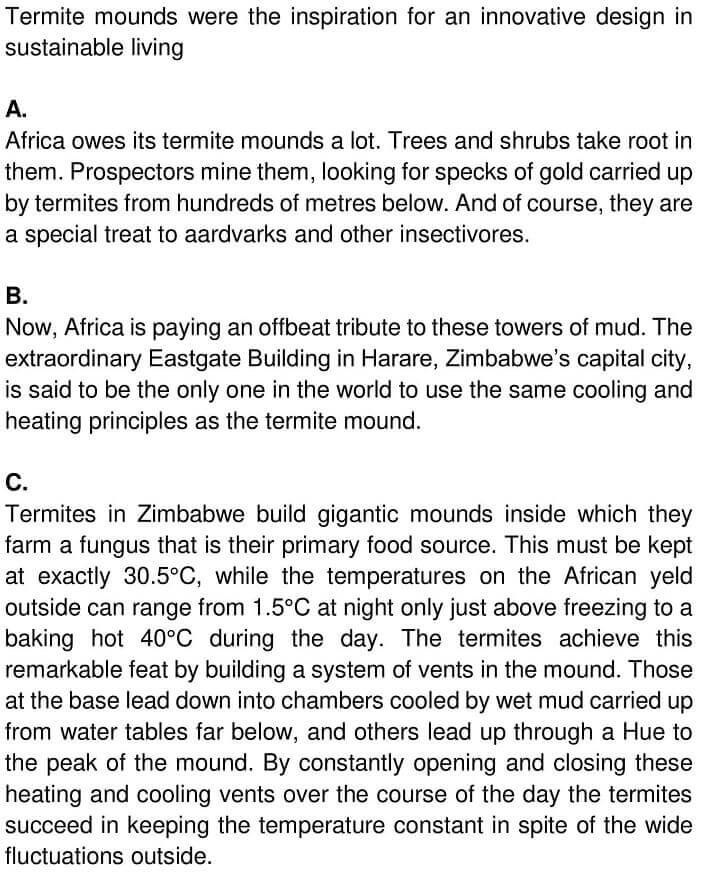
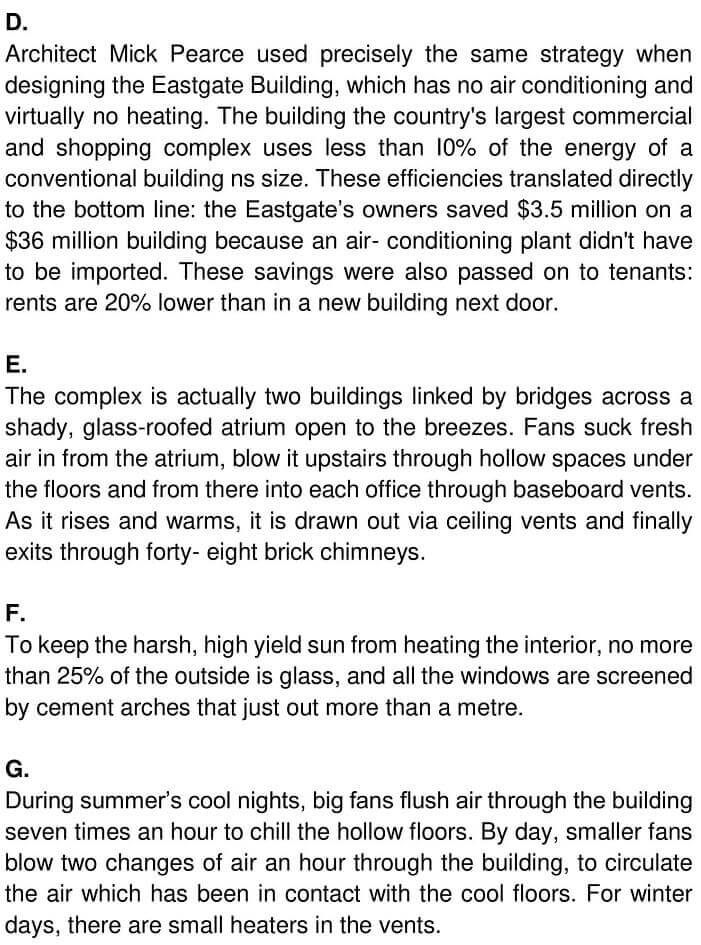
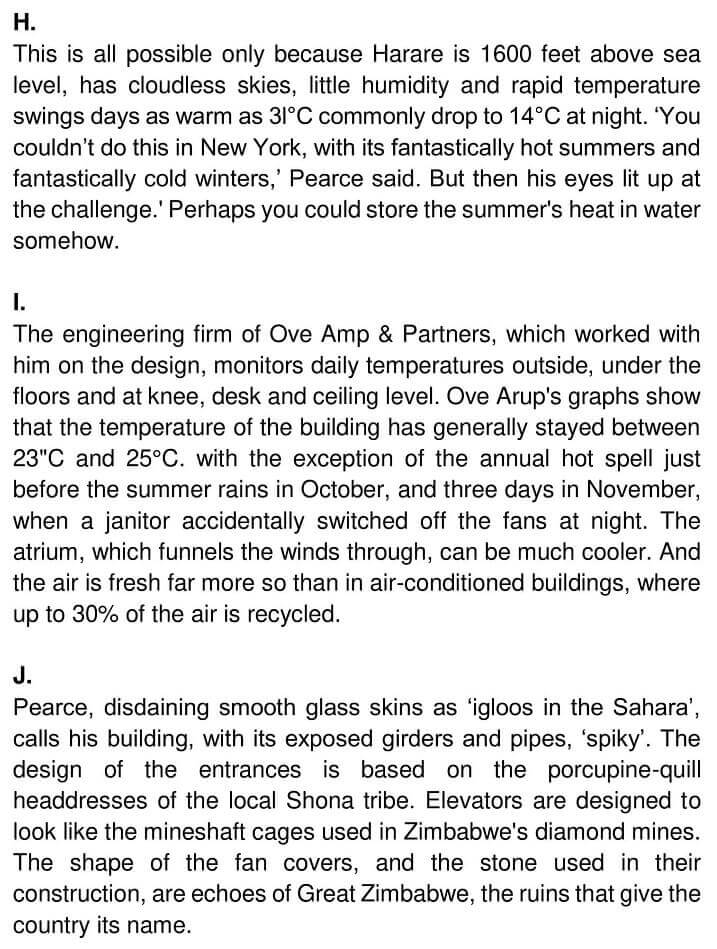
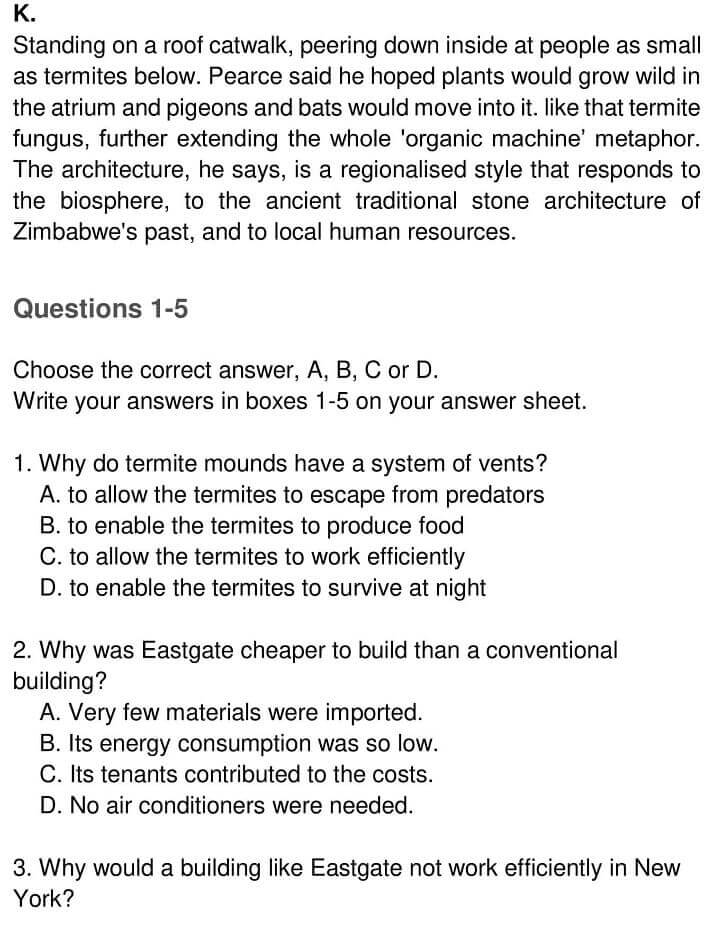
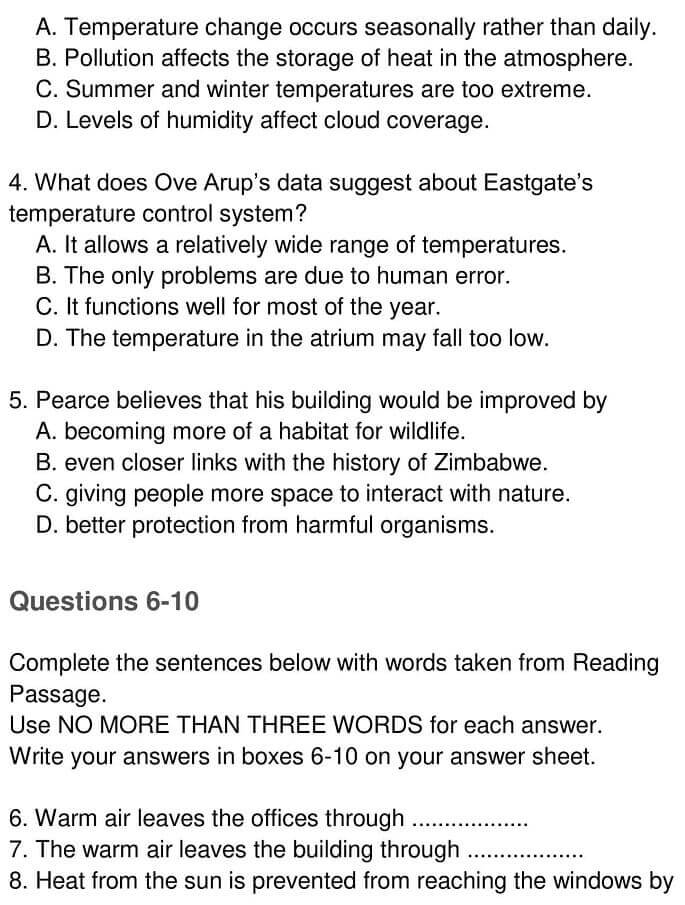
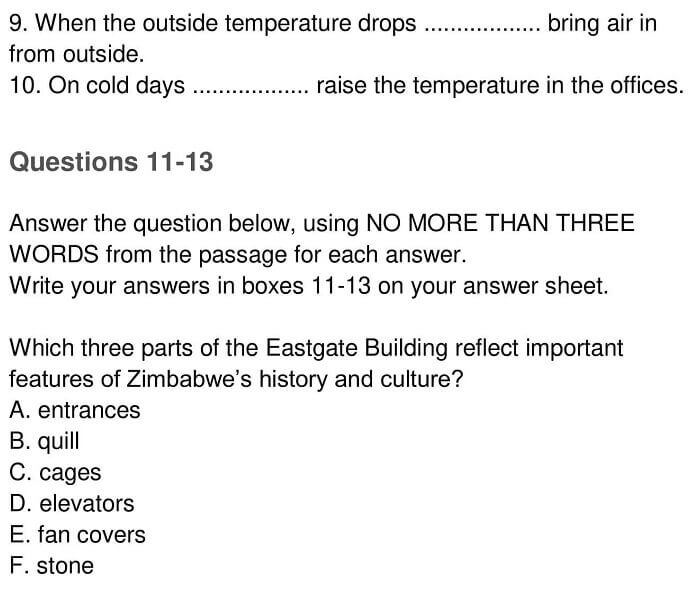
Want to boost your IELTS score? Enroll in our expert-led IELTS online classes today!
Sustainable Architecture Lessons from the Ant IELTS Reading Answers
Let’s now review the answers to the questions from the passage in the reading section, The Nobility of Indian Education IELTS Reading Answers, and assess your improvement for a high IELTS Reading band score.
| Question Number | Answers | Keywords | Location of Keywords |
|---|---|---|---|
| 1. | B | Termites in, build gigantic mounds inside which, that is their primary food source | Paragraph C, First 2 lines |
| 2. | D | Eastgate’s owners saved, air- conditioning plant didn’t have to be imported. | Paragraph D, Lines 6-8 |
| 3. | A | ‘You couldn’t do this in New York, hot summers and fantastically cold winters, | Paragraph H, Lines 4-5 |
| 4. | C | Temperature of the building has generally stayed | Paragraph I, Lines 4-6 |
| 5. | A | Pearce said he hoped plants would grow wild in the atrium, extending the whole ‘organic machine’ metaphor. | Paragraph K, Lines 2-4 |
| 6. | ceiling vents | Rises and warms, it is drawn out via ceiling vents | Paragraph E, Last 2 lines |
| 7. | (brick) chimneys | Finally exits through forty- eight brick chimneys. | Paragraph E, Last line |
| 8. | Cement arches | To keep the harsh, high yield sun from heating the interior, screened by cement arches | Paragraph F |
| 9. | Big fans | During summer’s cool nights, big fans flush air | Paragraph G, First 2 lines |
| 10. | (small) heaters | For winter days, there are small heaters | Paragraph G, Last line |
| 11. | A (in any order) | Entrances based on the porcupine-quill headdresses of the local Shona tribe | Paragraph J, Lines 3-4 |
| 12. | D (in any order) | Elevators, designed to look like the mineshaft cages used in Zimbabwe’s diamond mines. | Paragraph J, Lines 4-6 |
| 13. | E (in any order) | Shape of the fan covers, are echoes of Great Zimbabwe, | Paragraph J, Lines 6-7 |
Confused about IELTS prep? Join our exclusive IELTS webinar and clear all your doubts!
Tips to Solve Question Types in Sustainable Architecture Lessons from the Ant IELTS Reading Answers
Multiple Choice Questions (MCQ)
Reading Multiple Choice Questions require selecting the correct answer from a set of options based on information in the passage. This tests your careful reading and ability to distinguish subtle differences in meaning.
- Read the question carefully – Identify keywords and understand exactly what is being asked.
- Scan the passage for relevant information – Look for paragraphs or sentences that directly relate to the question.
- Eliminate clearly wrong options – Narrow down choices to increase your chances of selecting the correct answer.
- Watch for distractors – Some options may be partially true but not fully supported by the text.
- Pay attention to qualifiers – Words like “always,” “sometimes,” or “never” can change the meaning and indicate the correct option.
Sentence Completion
Reading Sentence Completion questions require filling in missing words or phrases in a sentence using information from the passage. This tests your ability to locate key ideas and understand grammar and context.
- Read the full sentence first – Understand the meaning before searching the passage.
- Look for keywords in the passage – Identify synonyms or paraphrases that match the sentence.
- Follow grammar rules – Make sure your answer fits grammatically with the sentence structure.
- Respect word limits – Stick to “NO MORE THAN ONE/TWO WORDS” instructions carefully.
- Check context before and after the blank – The surrounding words often guide the correct answer.
Matching Features
Reading Matching features questions ask you to connect features, characteristics, or functions with the correct items in the passage. This tests your ability to link details accurately.
- Understand each feature carefully – Know what you are looking for before scanning the text.
- Scan the passage for relevant details – Focus on paragraphs that discuss specific items or concepts.
- Look for synonyms and paraphrasing – The text may describe features differently from the question wording.
- Avoid repeating answers unless allowed – Some questions allow multiple matches; some don’t.
- Use process of elimination – Cross out options that clearly don’t match to narrow your choices.
Improve your IELTS Reading skills with our proven strategies. Sign up for our next webinar today!
By reviewing Sustainable Architecture: Lessons from the Ant with its 14 questions, you can strengthen your ability to identify key information, understand complex ideas, and manage time effectively in the IELTS Reading section. Practicing this passage and applying the tips for MCQs, Sentence Completion, and Matching Features will boost your accuracy and confidence, helping you aim for a higher band score.
Check More IELTS Reading Answers
Practice IELTS Reading based on question types

Start Preparing for IELTS: Get Your 10-Day Study Plan Today!
Recent Articles

Nehasri Ravishenbagam
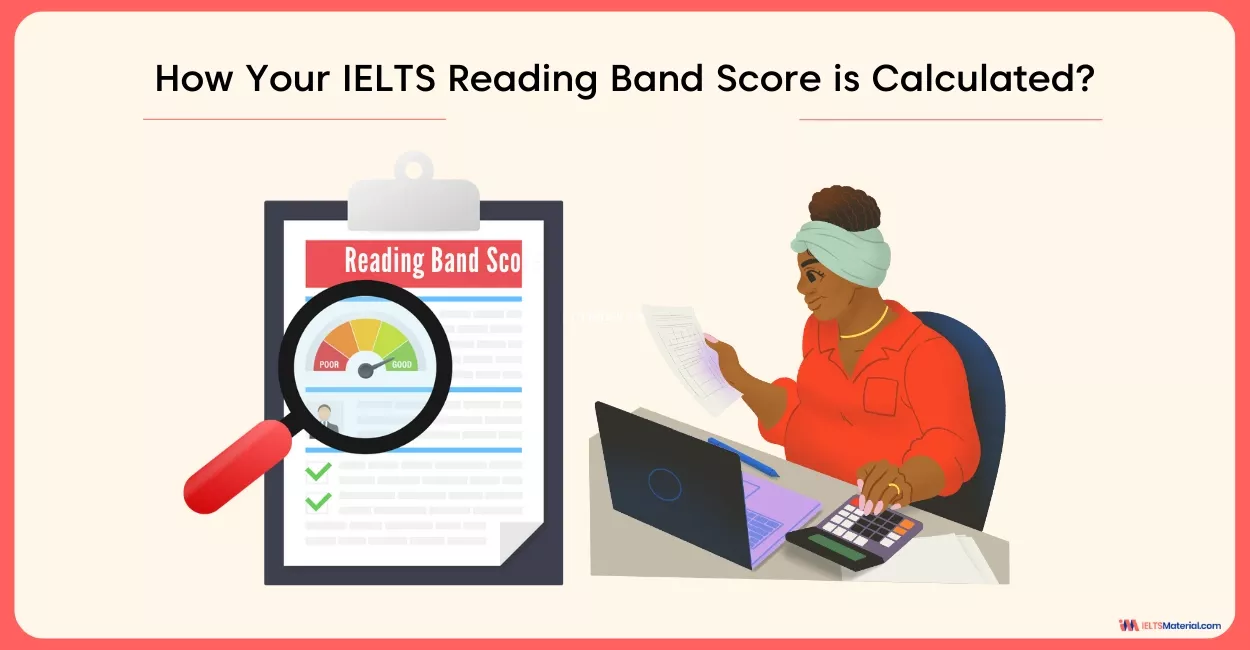
Haniya Yashfeen

Haniya Yashfeen

Haniya Yashfeen
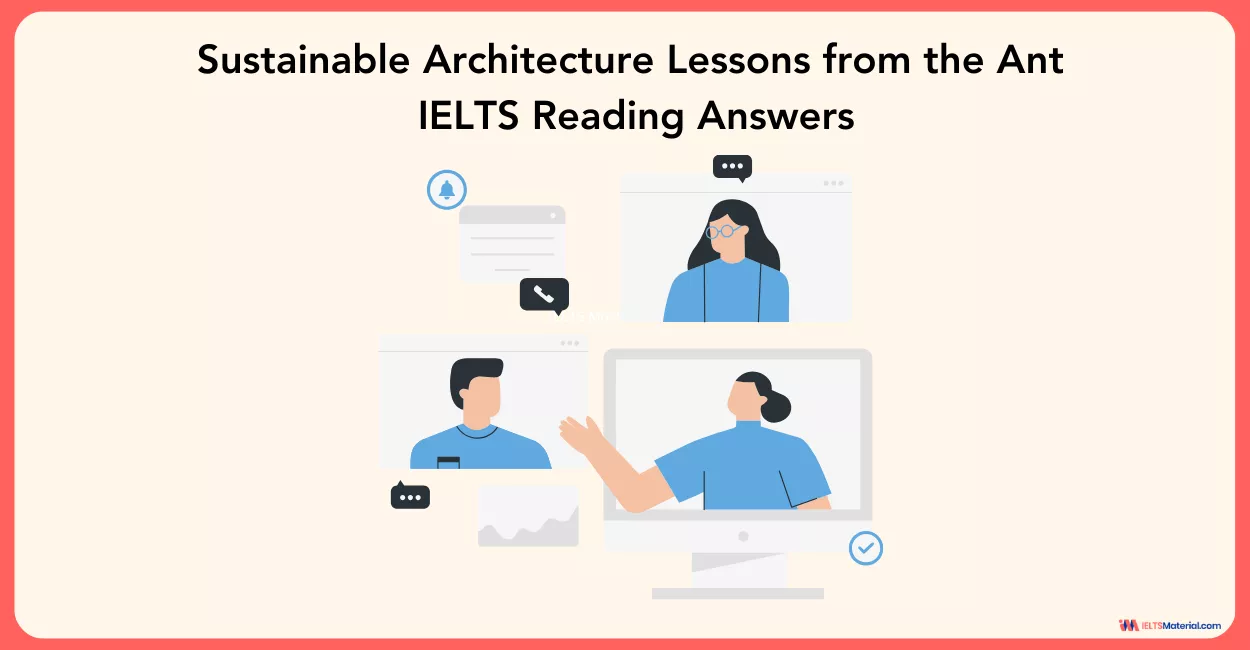



Post your Comments